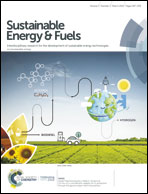A chitosan/poly(ethylene glycol)-ran-poly(propylene glycol) blend as an eco-benign separator and binder for quasi-solid-state supercapacitor applications†
Abstract
Herein, activated porous carbon (ACTS-900) derived from Tamarindus indica, a bio-source, via KOH activation and carbonization at 900 °C was used as an active electrode material for supercapacitor (SC) applications. In the three-electrode configuration, ACTS-900 shows the maximum specific capacitance (Cs,3E) of 225 F g−1 at 50 mV s−1 and 249 F g−1 at 0.5 A g−1 in 1 M H2SO4. A high-performance, bio-based, environmentally benign and cost-effective chitosan/poly(ethylene glycol)-ran-poly(propylene glycol) [Ch/poly(EG-ran-PG)]-based polymer blend was employed as a membrane-cum-separator as well as a green binder in the electrodes. The blend polymer membrane was prepared by mixing chitosan (Ch) and poly(EG-ran-PG) in a 1 : 1 weight ratio in a 1% aqueous acetic acid solution followed by drying under controlled evaporation. The blend membrane showed high porosity (2 μm–7 μm diameter pores) and excellent thermal (up to 250 °C), chemical (in 1 M H2SO4), electrochemical (up to 1.21 V) and mechanical stability (up to 39 MPa under tensile loading). The performance of a symmetric two-electrode SC device was evaluated using a H2SO4-(1 M)-soaked-Ch/poly(EG-ran-PG) membrane and ACTS-900 active electrode materials. The obtained results were compared with those obtained using commercially available binders and membranes. The single electrode specific capacitances (Cs,2E) in the symmetrical SC device were 193 F g−1 at 50 mV s−1 and 132 F g−1 at 2 A g−1 with H2SO4-(1 M)-soaked-Ch/poly(EG-ran-PG) as the membrane and binder. The maximum energy density and power density of the SC device are 4.7 W h kg−1 (at 1 A g−1) and 2.5 kW kg−1 (at 5 A g−1), respectively. Due to the superior wetting properties of the blend membrane and binder, excellent capacity retention was observed (∼99%) over 6000 cycles at the current density of 3.5 A g−1. As a proof-of-concept, a red light-emitting diode was illuminated using three serially connected 3 V SC stacks.


 Please wait while we load your content...
Please wait while we load your content...